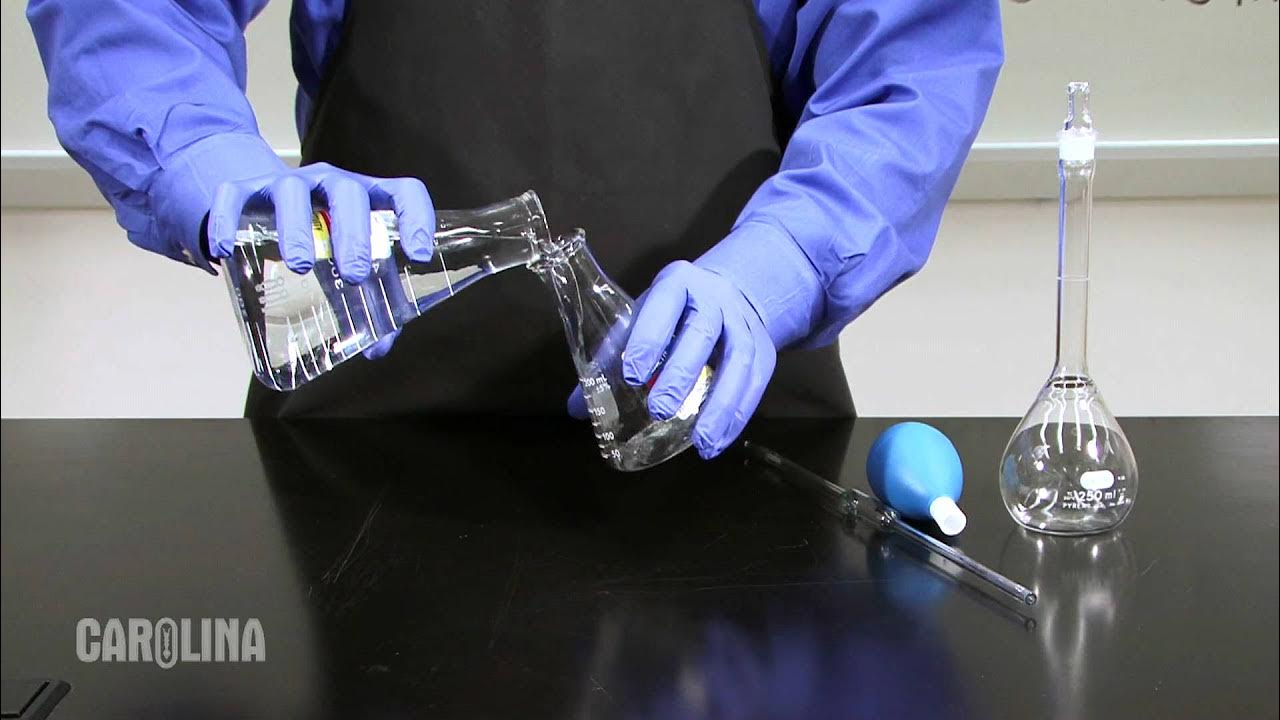Dilution of a Solution
Summary
TLDRIn this educational video, Patti demonstrates the process of preparing a concentrated stock solution of Copper II Sulfate and then diluting it to a known concentration. The three-step procedure includes calculating the required amount of compound, preparing the stock solution, and diluting it. Safety measures like lab coats, safety glasses, and gloves are emphasized. Patti uses 6.2 grams of Copper II Sulfate to create a 0.250-liter, 0.100 M stock solution and then dilutes it to a 0.250-liter, 0.004 M solution. The video covers the use of essential lab equipment and provides a hands-on guide to accurately measuring and mixing solutions.
Takeaways
- 🔬 The video demonstrates the process of preparing a concentrated stock solution and diluting it to a known concentration.
- 📝 The procedure is divided into three parts: calculating the amount of compound needed, preparing the stock solution, and preparing the diluted solution.
- 🧪 The example used is the preparation of a 0.250-liter, 0.100 M copper II sulfate stock solution, followed by diluting it to a 0.250-liter, 0.004 M solution.
- 💼 Safety equipment such as lab coats, safety glasses, and gloves are required for this procedure.
- ⚖️ The calculation for the amount of copper II sulfate pentahydrate needed is pre-completed, and 6.2 grams are required.
- 🔑 Accurate weighing is crucial; the script details how to use a scale to measure out the compound.
- 🌡️ The stock solution is prepared by dissolving the compound in distilled water and then diluting to the mark in a volumetric flask.
- 🏺 The diluted solution is prepared by accurately measuring out a specific volume of the stock solution and adding distilled water to the final volume in a volumetric flask.
- 📏 The script emphasizes the importance of careful measurement and technique to avoid errors, such as not exceeding the meniscus when making up to the mark.
- 🔍 The final step includes sealing the flask with parafilm, inverting to mix, and labeling the flask with the solution's name and concentration.
- 📈 The video concludes with a visual comparison of the stock and diluted solutions, noting the difference in color intensity.
Q & A
What is the purpose of preparing a concentrated stock solution in a laboratory?
-The purpose of preparing a concentrated stock solution is to have a known, high concentration of a compound that can be diluted to various lower concentrations as needed for different experiments or applications.
Why is it necessary to wear a lab coat, safety glasses, and gloves during the preparation of a stock solution?
-Wearing a lab coat, safety glasses, and gloves is necessary to protect the individual from potential hazards such as chemical splashes, inhalation of toxic fumes, and skin contact with chemicals, ensuring safety during the preparation of the stock solution.
What is the molar concentration of the copper II sulfate stock solution being prepared in the script?
-The molar concentration of the copper II sulfate stock solution being prepared is 0.100 moles per liter.
How much copper II sulfate pentahydrate is required to prepare 0.250 liters of a 0.100 M stock solution?
-6.2 grams of copper II sulfate pentahydrate are required to prepare 0.250 liters of a 0.100 M stock solution.
What is the significance of the meniscus when making up a solution to a specific volume in a volumetric flask?
-The meniscus is significant because it represents the curve seen at the top of the liquid in the flask. When making up a solution to a specific volume, the bottom of the meniscus should align with the calibration mark on the flask to ensure the correct volume is achieved.
Why is it important to rinse the weighing boat and funnel after transferring the compound into the volumetric flask?
-Rinsing the weighing boat and funnel after transferring the compound ensures that all the compound is transferred into the volumetric flask, preventing loss and ensuring the accuracy of the solution's concentration.
What is the final concentration of the diluted solution prepared from the copper II sulfate stock solution in the script?
-The final concentration of the diluted solution prepared from the copper II sulfate stock solution is 0.004 moles per liter.
How is the volume of stock solution required for dilution calculated?
-The volume of stock solution required for dilution is calculated using the formula v1 = (c2 * v2) / c1, where c2 is the desired concentration of the diluted solution, v2 is the volume of the diluted solution, and c1 is the concentration of the stock solution.
What is the role of parafilm in the preparation of the stock and diluted solutions?
-Parafilm is used to seal the volumetric flasks after preparation, preventing evaporation and contamination of the solutions, ensuring the stability and accuracy of the solution concentrations.
Why is it important to invert the volumetric flask several times after preparing the stock and diluted solutions?
-Inverting the volumetric flask several times helps to mix the solution thoroughly, ensuring that the solute is evenly distributed throughout the solvent and that the concentration is uniform.
Outlines

Cette section est réservée aux utilisateurs payants. Améliorez votre compte pour accéder à cette section.
Améliorer maintenantMindmap

Cette section est réservée aux utilisateurs payants. Améliorez votre compte pour accéder à cette section.
Améliorer maintenantKeywords

Cette section est réservée aux utilisateurs payants. Améliorez votre compte pour accéder à cette section.
Améliorer maintenantHighlights

Cette section est réservée aux utilisateurs payants. Améliorez votre compte pour accéder à cette section.
Améliorer maintenantTranscripts

Cette section est réservée aux utilisateurs payants. Améliorez votre compte pour accéder à cette section.
Améliorer maintenant5.0 / 5 (0 votes)






